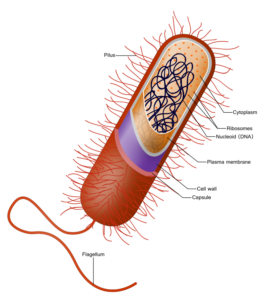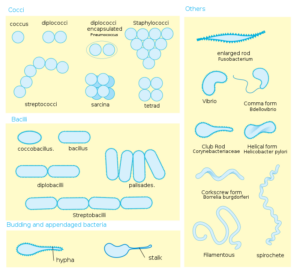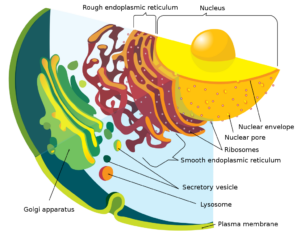The main difference between eukaryotic and prokaryotic (bacterial cells) lies in the assembly and presentation of the genomic material in the cells.
A Comparison Of Eukaryotic Cells vs Bacterial Cells:
| POINTS OF COMPARISON | BACTERIAL CELLS | EUKARYOTIC CELLS |
| Presence of Nucleus | Absent. They have something called a nucleoid instead. | Eukaryotic cells have a membrane-bound nucleus. |
| DNA arrangement | DNA or genetic material is usually double-stranded and arranged circularly. | DNA is made up of multiple double-stranded linear DNA. |
| Cellular complexity | Always unicellular | Can range from unicellular to multicellular. |
| Reproduction | Mitosis, Meiosis and fusion of gametes | Unidirectional DNA transfer and also cloning. |
| Chloroplasts | Absent. Chlorophyll is found scattered in the cytoplasm. | Present in plant and algal cells. |
| Cell wall | Present but made of peptidoglycans. | Present only in plant and algal cells. |
| Vacuoles | Present | Present |
| Cell size | 1-10 µM | 10-100 µM |
| Ribosomes | Present but smaller in size and fewer in number | Similarly present but greater in size and greater in number. |
| Other organelles | Bacterial cells do not have any other membrane-bound organelles. | The characteristic of eukaryotic cells is the presence of various cell organelles like – Endoplasmic Reticulum, Mitochondria and suchA table comparing Eukaryotic cells vs Bacterial Cells |
Characteristics of bacterial cells:
- Bacteria are small unicellular microscopic organisms that make up a major portion of prokaryotes.
- They can be free-living or host dependant. The ones that are host dependant may be parasitic or symbiotic.
- Bacteria belong to prokaryotic cell organization, which means that they do not have an organized and membrane-bound genetic material.
- Instead, they have a nucleoid – a mass of genetic material floating about in the cell cytoplasm.
- They can survive in the harshest environmental conditions including the gut of various other organisms.
- Bacterial cells also do not have any form of membrane-bound organelles in their system.
- Since a lot of them are free-living they have structures like flagella which help them to locomote.
- Others that depend on hosts have structures like pilli or fimbriae that allow DNNA transfer(in case of infection) or cellular attachment respectively
- They are mainly differentiated on their shapes- spherical, rod-shaped or spiral.
- They are respectively named coccus, bacillus or spirullus.
- They have a peptidoglycan cell wall that can be stained using some specific chemicals.
- Based on the type of stain that the cell wall catches they can bed distinguished into Gram-positive and Gram-negative bacterial cells.

Some examples of Bacteria:
Some bacteria have found the ability to love in the most adverse environments, while some have beneficial effects on natural flora and fauna. They can also cause various diseases that may even be fatal. Here we will look at some of them:

- Halophiles: These bacteria live in extremely salty environments where most other organisms cannot survive.
- Acidophiles: These bacteria like in highly acidic environments.
- Alkaliphiles: These bacteria on the other hand live in extremely alkaline environments with extremely high pH.
- Psychrophile: These bacteria live in cryogenic temperatures below 0 degrees Celcius in places like glaciers and polar snow caps.
- Nitrogen-fixing bacteria: Nitrogen-fixing bacteria live in the soil or the root nodules of leguminous and fix atmospheric nitrogen either into the plant root or into the soil directly.
- Beneficial bacteria: These bacteria can live in the gut(intestine) of larger animals. They help break down nutrients for better absorption. Some of them also synthesize Vitamins that keep the intestinal flora and fauna(beneficial organisms in the gut) healthy.
- Commercially useful bacteria: Some bacteria like Lactobacillus is used commercially and also at home for the preparation of curd and cheese.
- Pathogenic bacteria: Not all bacteria are beneficial. We mostly associate bacteria as disease-causing pathogens. They can cause diseases in both plants and animals, that can also be life-threatening. Some bacterial diseases can wipe out a year’s worth of crops. In humans, they can cause typhoid, pneumonia, tuberculosis and many more. Before the discovery of vaccines and antibiotics these diseases had caused massive numbers of deaths.
Characteristics of Eukaryotic Cells:
- These cells are ones with a true kernel or nucleus i.e. they have a nucleus containing the genetic material bound by a nuclear membrane.
- These cells also have various other membrane-bound organelles.
- Eukaryotic cells can be individual unicellular organisms, but they can also associate to form multicellular organisms.
- Consist of protists, algae, plant and animal cells.
- Some cells like plant and algal cells have a polysaccharide cell wall made of cellulose and chitin respectively.
- They also contain organelles like mitochondria, chloroplast and ribosomes that have specific functions.

Image: Wikipedia
What can be found in eukaryotic cells but not in bacteria?
The most important distinguishing factor between eukaryotic and bacterial cells is the presence and absence of the nucleus respectively. In bacterial cells, the genetic material is arranged in a circular material called a nucleoid. There is no membrane covering the genetic material so we can say that it practically floats in the cytoplasm of the bacteria.
Another important characteristic of eukaryotic cells is the presence of other membrane-bound organelles. This is also absent in bacterial cells as they are nearly devoid of any extra organelles. Bacteria are structurally very simple organisms.
What do bacteria and eukaryotes have in common?
On closer look bacterial cells are in some ways similar to plant cells in general:
- Bacterial cells also have a cell wall like plant cells-though they are made up of peptidoglycans instead of cellulose or pectin.
- A lot of bacterial cells photosynthesize and have green pigments for this purpose.
- Ribosomes are the only organelles present in bacterial cells like eukaryotic cells. This is because ribosomes are essential in protein synthesis, hence equally important in bacterial as in eukaryotes.
- In photosynthetic bacteria, the chlorophyll pigments are scattered in the cell cytoplasm due to the absence of chloroplasts.
Conclusion:
Bacteria arrived on Earth millions of years before the advent of simple unicellular eukaryotic organisms. Even then they have managed to survive to this day without having to undergo any major adaptations or evolutions. This is probably why they could survive over the harsh atmospheric changes. Hence bacteria have acquired the ability to live in all circumstances and environments where no other organism can dream of surviving. Though they seem lacking in comparison to eukaryotes in terms of size or complexity they are still much more individually capable
Also Read:
- Is fungi multicellular or unicellular
- Bacterial cell type
- Are yeast multicellular
- Does fungi have a cell wall
- Is cyanobacteria unicellular or multicellular
- Photocell sensors
- What happens to a cell in a hypotonic solution
- Fuel cell aircraft

I am Trisha Dey, a postgraduate in Bioinformatics. I pursued my graduate degree in Biochemistry. I love reading .I also have a passion for learning new languages.
Let’s connect through linked in: